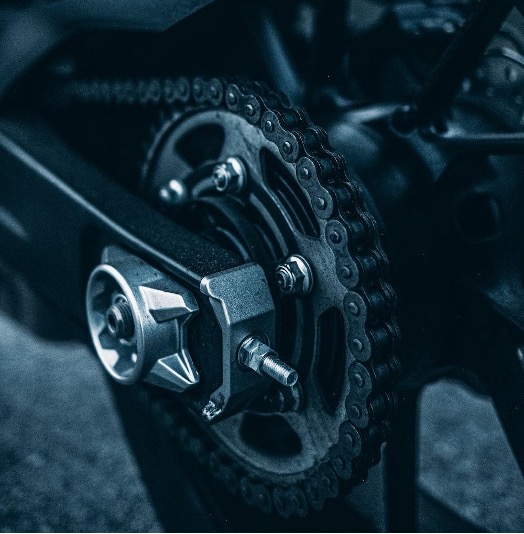The chain is an incredibly important part of any motorcycle. They provide the gears and drive that spin the rear wheel and actually make the bike accelerate. Even though chain alternatives – such as belts and driveshafts – are available they still pale in comparison to good old-fashioned chains.
Motorcycle chains come in two categories: unsealed and sealed. Unsealed chains are more common on vintage bikes and older models, and need constant lubrication to ensure they function effectively. Sealed chains, on the other hand, use small rubber components to lock in grease on the chains and sprockets. This keeps them lubricated for much longer.
There are two main types of sealed motorcycle chains: the O-ring chain and the X-ring chain. As their names suggest, the core difference is in the shape of the rubber sealants that sit in between the chain plates. They each have their own pros and cons, which we’ll explore in this article. By the end, you’ll know everything there is to know about O-ring and X-ring chains and you’ll be able to determine which one is right for your next bike.

O-ring chains are fairly self-explanatory. They consist of rubber O-shaped rings that fit around the pins in between the inner and outer plates. They reduce the metal-on-metal contact and seal lubricant into the gaps in the inner chain components. This keeps the entire component – including the outer chain plates – well-greased, enabling it to function smoothly with reduced friction between the links.
Non-O-ring chains are typically of lesser performance and require frequent manual lubrication. These are found on bicycles and older motorbike models but have since been almost entirely replaced by either O-ring or X-ring chains. This is simply because O-ring chains provide better drive and improved protection against dirt and dust.
The invention of the O-ring chain revolutionized the motorcycle industry. Chain maintenance became a lot less effort, as your motorcycle chain would retain a lot more lubrication and perform reliably for longer. Of course, you still need to apply lubrication every now and then for O-rings, but you can drive significantly further before you have to re-grease your chain.
There are many benefits to O-ring chains, which is why they have remained a popular choice ever since their invention in the 1970s. Below, you’ll find some of the key benefits of O-ring chains that validate their continued popularity over the years:
● Improved lubrication: The vacuum-sealed grease inside the O-rings provides near-constant lubrication for the inner chain plates. The average motorcycle with an O-ring chain typically outperforms the average non-O-ring chain bike (such as one with a standard roller chain), because the inner parts are well-oiled and will provide better drive as a result.
● Extended service life: Similarly, O-ring chains provide improved longevity to your bike because of the extra lubrication throughout the chain. This produces less friction among the link plates, reducing general wear-and-tear and keeping your bike parts performing well for longer. Plus, the O-rings protect your inner chain parts from external forces like weather damage, water, dirt, and dust.
● Less maintenance: When compared to a standard roller chain, O-ring chains need a lot less routine maintenance. You don’t have to apply lubrication for around 500 kilometers, which is almost 5 times longer than with an ordinary chain. On top of this, replacing your chain is easier and less frequent.
While O-ring chains are very beneficial to many motorcyclists, there are some downsides to them. Some of these won’t affect you if you don’t intend to use your bike for off-road or track racing purposes, but avid racers might want to consider other types of chains. Here are some typical disadvantages of O-ring chains:
● Increased drag: The O-shape of the rings create a larger surface area over which drag and friction can act on the inner chain links and pins. This, in turn, reduces the drive that the chain can provide to the rear wheel, ultimately sapping the bike’s top speed potential.
● Less suitable for off-roading: In a similar vein, O-ring bikes are less suited to off-road areas than X-ring bikes. This is because the drive that’s created in an X-ring chain gives the rear wheel more power to tackle tough terrains. While an O-ring motorbike is still suitable for off-road paths, X-rings perform better in these areas.
O-ring chains are designed for general purposes, so they can be used across a variety of different functions. However, there are certain occasions where an O-ring chain may be more or less appropriate than other types of chain.
For instance, off-road biking is more suited for X-ring chains than O-ring chains. Similarly, speed racing suits X-rings more, since they provide less drag and increased power to the rear wheel. Ultimately, this means X-ring chains add that little extra speed that’s so vital in shaving off a few seconds on your lap time.

X-ring chains were designed as an upgrade on the O-ring format in a meticulous attempt to improve overall speed. Top engineers realized that the O-rings enact drag on the chain due to their large surface area over the components. To remove some of this drag and provide better power for the rear wheel, they invented the X-ring chain.
Instead of a circular ring, the X-ring has a small X-shape in the middle with each of the four points touching the inner chain components. While there are more touchpoints than in an O-ring chain, the overall surface area is reduced, creating less drag and more drive for the bike. Additionally, the reduced force on the other components gives improved longevity to the chain.
Because X-ring chains were developed for the track, they’re often made from stronger materials and are significantly more expensive. They’re much better for track use and offer a significant upgrade to dirt bike chains, but are often not worth the extra expenditure for casual or road-only riders.
X-ring chains can bring significant benefits to your motorbike, mostly in the remit of speed and performance. Here are some of the main advantages of X-ring chains:
● Reduced drag: Due to its X-shaped design, the X-ring chain covers a lesser surface area over the inner components than its O-shaped counterpart. This means that it enacts less force onto the chain itself and thus produces less drag, giving the bike a better and more efficient overall performance.
● Better distortion resistance: X-ring chains hold their shape longer since they’re made from more durable materials. Over time, other types of rings can become deformed and distorted, which reduces the bike’s performance. As a result of their shape and strength, X-ring chains don’t deform as easily and therefore don’t need replacing as frequently.
● Higher top speeds: With reduced drag on the chain, X-rings can transfer more power from the mechanism to the back wheel. This gives the motorbike a faster top speed and increases its acceleration. This is a big reason why X-rings are primarily used by racers.
There are so many advantages to using an X-ring chain, but they all mean nothing if you’re not willing to part with a hefty sum of cash. The overwhelming disadvantage of X-ring chains is that they’re much more expensive than other types of chains. Read below for more detail on the downsides of X-rings:
● More expensive: X-ring chains are often made from stronger, tougher, and higher-quality material. This means they’re often accordingly (but expensively) priced. If you don’t require an X-ring chain for speed, quality, or bragging rights, you’re likely better suited to a more affordable, but still highly rated, O-ring chain.
● Sometimes only suited to certain models: X-rings are meant for high-performance bikes, so it may be the case that there are no X-ring chains that suit your model, or that they’re much more difficult to get hold of. As a result, many people are better off sticking to an O-ring chain.
When to Use an X-Ring Chain
X-ring chains are often preferred by avid racers and highly enthusiastic bikers since they’re a lot more expensive than standard or O-ring chains. If you’re a frequent track racer or fanatical collector, you may justify the extra expenditure since X-rings provide boosted speed and reduced drag in your bike. However, if you’re less bothered about off-road racing, you may prefer to stick to an O-ring chain, which still offers a wealth of benefits.

By now you’ve probably realized that buying motorbike parts is relatively complicated. There are so many specification choices that it can be hard to determine which one is the right fit for you. Avid enthusiasts will likely already have their criteria researched and specific models in mind. But, if you’re a little more hesitant, you should first consider a few important factors.
Before rushing into buying a new chain, it’s important to know that your bike will give you the right type of ride. Here are a few questions you should ask yourself before choosing whether you want an O-ring or X-ring chain for your motorcycle:
● What do you want to use your motorbike for? Since X-ring chains were originally developed for track racing, they remain the best choice for avid racers. If you’re not a racer or don’t own a dirt bike, X-ring chains may not be the most appropriate choice for you. O-rings offer a much better and cheaper alternative for road use.
● What is your budget? The higher quality components of X-ring chains make them exceedingly expensive. As a result, many casual motorbike riders opt for rubber O-rings to save money, considering that they don’t need the racetrack-adapted qualities of X-ring chains. If you’re on a budget, O-ring chains are a more sensible purchase.
● What size and model is your bike? There’s no point in buying a chain that doesn’t fit on your bike. If the only X-ring Harley Davidson chains you can find are too small for your large bike, you’re better off sticking to an appropriately sized O-ring chain. Always check the specifications of your bike before buying a chain.
Frequently Asked Questions
Still, got some questions relating to motorcycle chains. Here, you’ll find some FAQs on both O-ring and X-ring chains, as well as general information on care and upkeep. Always remember to do your research before choosing a chain for your bike, or indeed a motorcycle in the first place, as your final decision will need to suit your requirements.
Is an O-Ring Motorcycle Chain Better Than an X-Ring?
Because they each have their own pros and cons, you cannot say for definite that an O-ring is better than an X-ring chain. In many ways, the X-ring chain outperforms the O-ring chain, giving higher quality specifications and better properties to your motorbike. But, the higher costs that come with it can make the O-ring chain a better overall choice.
What is the Lifespan of an O-Ring Motorcycle Chain?
The longevity of your O-ring bike chain components will depend on their quality. Standard O-ring chains should last you around 15,000 – 20,000 kilometers, whereas the best quality ones can give you a hassle-free ride of up to 30,000 kilometers. Of course, this assumes you take good care of your bike and regularly clean your chain.
How often should you lubricate a motorcycle O-ring chain?
You should aim to apply fresh lubricant to your O-ring every 400 – 800 kilometers. This ensures your bike will remain safe and perform reliably, keeping your journeys hassle-free as much as possible. If you tend to use your motorbike off-road, your O-ring may need lubricating more frequently.
Brief Video Explanation
Join our mailing list to be the first one to know more new parts release and marketing info. Stay informed!


We will contact you within 1 working day, please pay attention to the email “wholesale@mpm-motorsports.com”
Comments